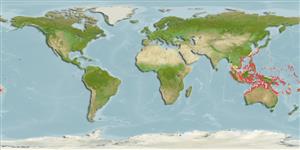>
Acanthuriformes (Surgeonfishes) >
Siganidae (Rabbitfishes)
Etymology: Siganus: Latin, siganus = a fish, rabbit fish; by the similarity of the nose (Ref. 45335).
More on author: Schlegel.
Environment: milieu / climate zone / depth range / distribution range
Écologie
marin récifal; profondeur 1 - 30 m (Ref. 9710), usually 2 - 30 m (Ref. 27115). Tropical; 22°C - 27°C (Ref. 27115); 32°N - 25°S, 97°E - 174°W
Indo-West Pacific: Cocos-Keeling Islands and the South China Sea to the Gilbert Islands, north to the Ryukyu Islands, south to the southern Great Barrier Reef and New Caledonia (Ref. 37816).
Taille / Poids / Âge
Maturity: Lm ? range ? - ? cm
Max length : 38.0 cm TL mâle / non sexé; (Ref. 2334); common length : 25.0 cm TL mâle / non sexé; (Ref. 9813)
Épines dorsales (Total): 13; Rayons mous dorsaux (Total): 10; Épines anales 7; Rayons mous anaux: 9; Vertèbres: 13. Body yellow-orange above to silvery white below; a prominent blackish bar on head, spotted; iris blackish; opercular area silver; dorsal and anal fin spines and rays yellow, spines with white streak. Spines stout and venomous. Preopercular angle 101°-111°. Cheeks fully covered with strong scales. Midline of thorax scaled; scaled pelvic ridges may interrupt scale row pattern. Low rim of anterior nostril expanded posteriorly into a short, broad triangular flap.
Occurs in shallow, coral-rich areas of clear lagoons and seaward reefs. Individuals up to 7 cm SL forms large schools in shallows, lagoons and outer reef flats, particularly in areas dominated by luxurious growths of Acropora. Adults occur in pairs. Juveniles feed on filamentous algae, adults on algae, tunicates, and sponges (Ref. 9813, 48637). Can inflict painful stings (Ref. 4690).
Life cycle and mating behavior
Maturité | Reproduction | Frai | Œufs | Fécondité | Larves
Woodland, D.J., 1990. Revision of the fish family Siganidae with descriptions of two new species and comments on distribution and biology. Indo-Pac. Fish. (19):136 p. (Ref. 1419)
Statut dans la liste rouge de l'IUCN (Ref. 130435)
Utilisations par l'homme
Pêcheries: intérêt commercial mineur; Aquarium: Commercial
Plus d'informations
RéférencesAquacultureProfil d'aquacultureSouchesGénétiqueElectrophoresesHéritabilitéPathologiesTraitementNutrientsMass conversion
Outils
Articles particuliers
Télécharger en XML
Sources Internet
Estimates based on models
Preferred temperature (Ref.
123201): 24.7 - 29, mean 27.7 °C (based on 722 cells).
Phylogenetic diversity index (Ref.
82804): PD
50 = 0.5000 [Uniqueness, from 0.5 = low to 2.0 = high].
Bayesian length-weight: a=0.01230 (0.00706 - 0.02143), b=2.98 (2.83 - 3.13), in cm total length, based on LWR estimates for this species & Genus-body shape (Ref.
93245).
Niveau trophique (Ref.
69278): 3.0 ±0.00 se; based on food items.
Résilience (Ref.
120179): Haut, temps minimum de doublement de population inférieur à 15 mois (Preliminary K or Fecundity.).
Fishing Vulnerability (Ref.
59153): Low to moderate vulnerability (28 of 100).
Nutrients (Ref.
124155): Calcium = 34.8 [16.6, 77.5] mg/100g; Iron = 0.646 [0.310, 1.327] mg/100g; Protein = 19.3 [18.0, 20.7] %; Omega3 = 0.144 [0.081, 0.258] g/100g; Selenium = 20 [9, 45] μg/100g; VitaminA = 52.5 [21.1, 132.1] μg/100g; Zinc = 1.23 [0.51, 2.40] mg/100g (wet weight);
